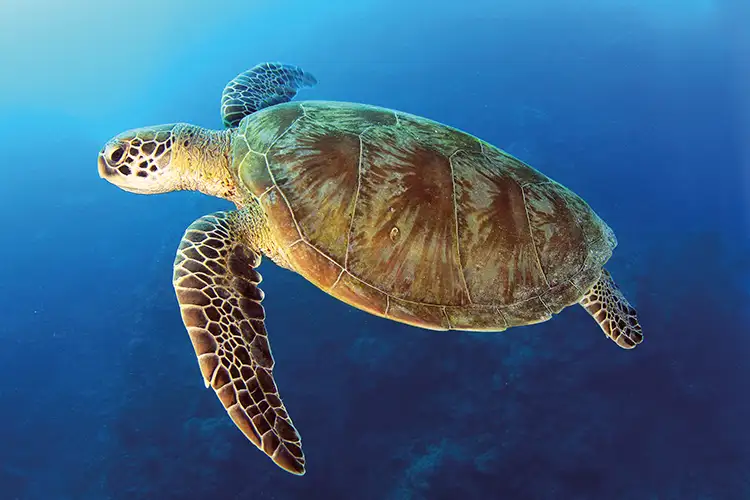

It took decades to break the balance between ocean life and human demand. Now a new wave of innovation, enforcement and cooperation is trying to restore it
By
The common interest in healthy fish stocks means that solutions must involve support from conservationists, scientists and fishers. One such example is the deployment of Turtle Excluder Devices (TEDs) in waters off northern Australia, where six species of sea turtle come into conflict with significant prawn and scallop trawl fisheries. According to WWF Australia, bycatch is the leading cause of death for cetaceans, turtles, dugongs, sharks and seabirds – and some populations are likely to become extinct due to repeated encounters with fishing gear. The issue is particularly acute for green and hawksbill turtles.
After the Australian Fisheries Management Authority found that longline tuna fishing off Australia’s east coast was killing sea turtles in a bycatch ‘hotspot’ in the Coral Sea in the 2010s, it mandated TEDs and other bycatch-reduction devices across Queensland and northern prawn fisheries.
TEDs use the flow of water through the trawl net to guide turtles towards an escape hole. They feature a rigid barrier grid, attached to the net’s circumference, which diverts turtles upwards or downwards and out of the net. Similar grids enable small species to escape but block larger animals from reaching the codend, while still allowing prawns to pass through the bars. WWF Australia says TEDs can reduce turtle bycatch by 99 per cent, seasnakes by five per cent, sharks by 17.7 per cent, rays by 36.3 per cent and large sponges by 85.3 per cent. A variation – the Trash and Turtle Excluder Device – reduces fish bycatch by up to 40 per cent and also removes debris from the water. In the USA, testing by the National Oceanic and Atmospheric Administration has reinforced these results, concluding earlier this year that TEDs are 97 per cent effective at keeping turtles out of shrimp trawl nets.
Chris Graham of the Marine Conservation Society is keen to highlight increasing examples of sustainable fishing. ‘Establishing marine protected areas and enforcing effective fisheries management are vital steps in preserving ocean health,’ he says. ‘Many fishers are adopting more sustainable practices – from using selective gear that reduces bycatch to observing science-based catch limits that prevent overfishing and help minimise environmental impact.’

Enjoying this article? Check out our related reads:
Research in UK waters shows how protection can benefit both biodiversity and the fishing sector. Lyme Bay in Dorset is a marine biodiversity hotspot, home to more than 1,300 species of fauna and flora, including the UK’s largest colony of pink sea fans and the rare sunset coral. In 2008, 206 square kilometres of Lyme Bay was closed to seabed trawling and dredging to protect the reefs – but static gear (pots, nets, scallop diving, rod and line) was still allowed. Over the following 17 years, the reserve saw a 52 per cent increase in species diversity and 370 per cent more commercial species abundance inside the protected area compared with outside it.
Around the Isle of Man, sections of sea are rotated – like leaving agricultural land fallow – to enable fish to replenish. This is supported by bans on bottom trawling in three main sites and licensing for scallops, crabs and lobsters. A more recent breakthrough involves the discovery that scallops are attracted to light, enabling them to be harvested using crab pots fitted with LED lights instead of by dredging. The technique is already being used in British waters from Devon to Orkney. The scallops – inevitably dubbed ‘disco scallops’ – are thought to mistake the lights for plankton.

At a global level, conservation efforts are now focused on a major meeting of CITES this November, which is expected to impose the highest level of protection – a ban on commercial trade – for whale sharks, oceanic whitetips and manta and devil rays. More than 70 species of shark and ray are under review. While 90 per cent of the shark fin trade has been regulated over the past decade, new proposals seek to close loopholes around trade in shark oil and meat. Measures are also being developed for wedgefish and guitarfish rays – the most threatened families of shark and ray, whose fins fetch the highest price of any species – and gulper sharks, which are being hunted for their high- value liver oil, used in luxury cosmetics, and thought to have suffered declines of more than 80 per cent in some areas.
‘We have the science, the tools and the international frameworks to manage ocean resources sustainably. We just need the will to use them,’ says Manuel Barange, UNFAO assistant director-general and director of the Fisheries and Aquaculture Division ‘When countries and organisations invest in science, enforcement, capacity building and inclusive governance, sustainability follows. What we need now is to scale up what already works.’






